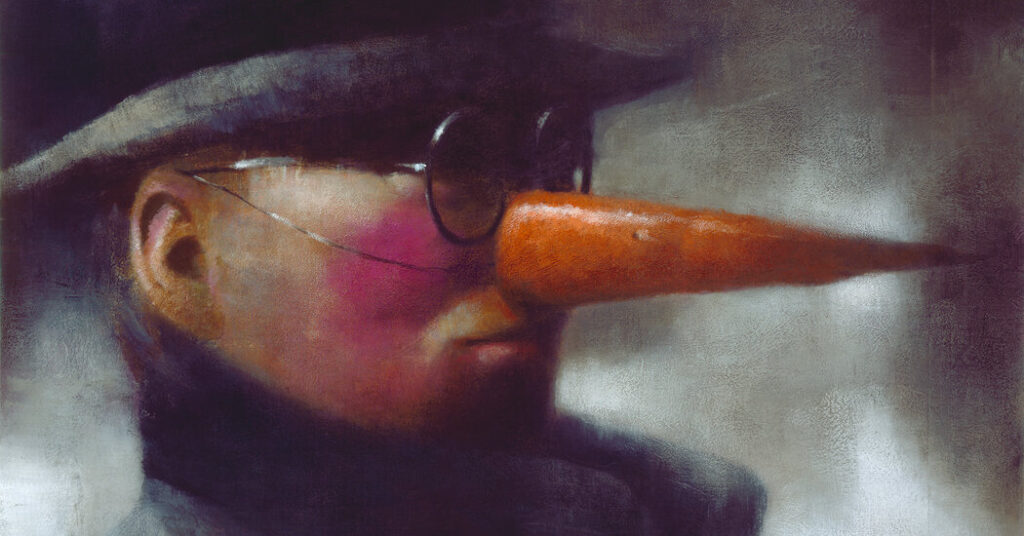Brad Holland, an artist whose conceptual work and iconoclastic ways delighted — and often maddened — generations of art directors, died on March 27.
He was an early bloomer.
While his fellow ninth graders were winning blue ribbons in art class for drawings of cocker spaniels and hot rods, he once told an interviewer, he was collecting rejection letters from The Saturday Evening Post and Walt Disney.
Mr. Holland got his big break when he was 23. Arthur Paul, Playboy magazine’s celebrated art director, decided to flout company policy by giving him an assignment, even though he refused to take direction.
Like most magazines, Playboy told its illustrators what to provide — almost always a literal interpretation of the work. But Mr. Paul was game enough to let him have his head, setting a precedent that Mr. Holland would follow for the rest of his life.
This particular assignment was to illustrate an essay by P.G. Wodehouse, the British author and humorist who created Jeeves, the consummate butler to the hapless Bertie Wooster. For Mr. Wodehouse’s essay, on his own “servant problem,” Mr. Holland delivered a series of elaborate pen-and-ink drawings of toffs manipulating tiny servant puppets, drawings that recalled the satirical work of the 19th-century British caricaturist Thomas Nast.
“I find it rather difficult to pin down my feelings about those illustrations to my Domestic Servant piece,” Mr. Wodehouse wrote to Mr. Paul after his piece ran. “My initial reaction was a startled, ‘Oh, my Gawd!’ but gradually the sensation that I had been slapped between the eyes with a wet fish waned, and now I like them very much.”
It was perhaps a typical response to Mr. Holland’s virtuosic, if often baffling, work. His strange and magical imagery (and his stubborn methods) reinvented illustration.
Before long, his work seemed to be everywhere — on magazine, book and album covers, in advertisements, on posters for theater productions and political causes — and Mr. Holland was considered one of the most sought-after, and impactful, commercial artists of the late 20th century.
When The New York Times introduced its opinion page in 1970, Mr. Holland was one of its signature artists, helping to chronicle the Watergate scandal and the oil crisis, among other national and global events.
“I never liked illustrations,” Mr. Holland said. “They were ghosts of ideas, transparent, vaporous. I wanted my drawings to engage. When I tackled the Watergate hearings or the formation of OPEC, I internalized the public issues. Then I rooted through the junkyard of preconsciousness. The pictures that came out were ink blots. See in them what you want.”
Mr. Holland worked mostly in acrylic, on Masonite panels or illustration boards, but he was stylistically and technically agnostic.
“My models were always writers, guys who could write essays, poetry, plays, whatever they chose, and try different approaches,” he told the art director Steven Heller in 2005. “There’s no reason why an artist can’t take a similar approach. Use charcoal one day and bright colors the next. Do a series of white-on-white paintings and then do a handful of messy drawings as if you were five years old. I mean, you can’t get everything into a single picture. Every picture is just an elephant. Everyday you feel a new part of who you are.”
One of Mr. Holland’s last projects was illustrating “It Happened in Salem” (2024), a children’s book about the Salem witch trials — and a timely cautionary tale about the power of rumor — by Jonah Winter. The book’s art director, Rita Marshall, had long admired Mr. Holland’s work, but she was put off by his famously prickly persona.
When she phoned him, she recalled in an interview, “he reprimanded me for waiting 40 years to give him a book. I told him I was afraid of his bad-boy reputation and thought he would be difficult to work with. He replied, ‘But Rita, I’m an Eagle Scout and am very nice to work with.’”
As it happens, she said, he was.
https://www.nytimes.com/2025/04/14/arts/brad-holland-illustrations.html


